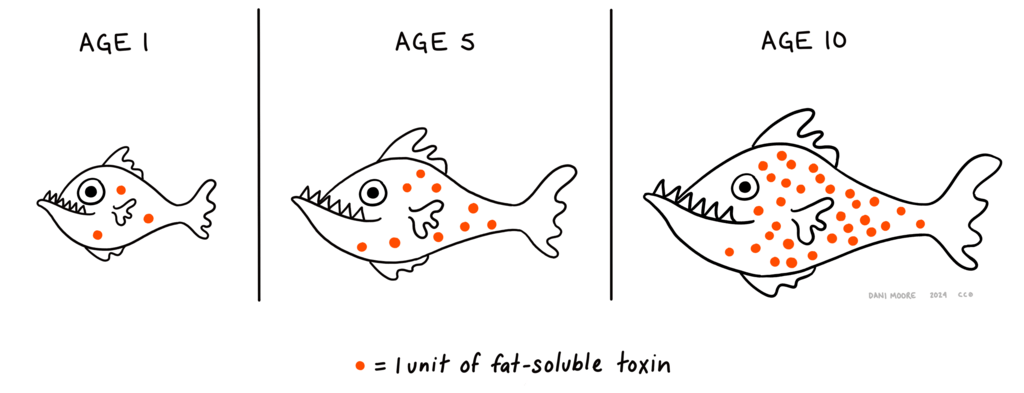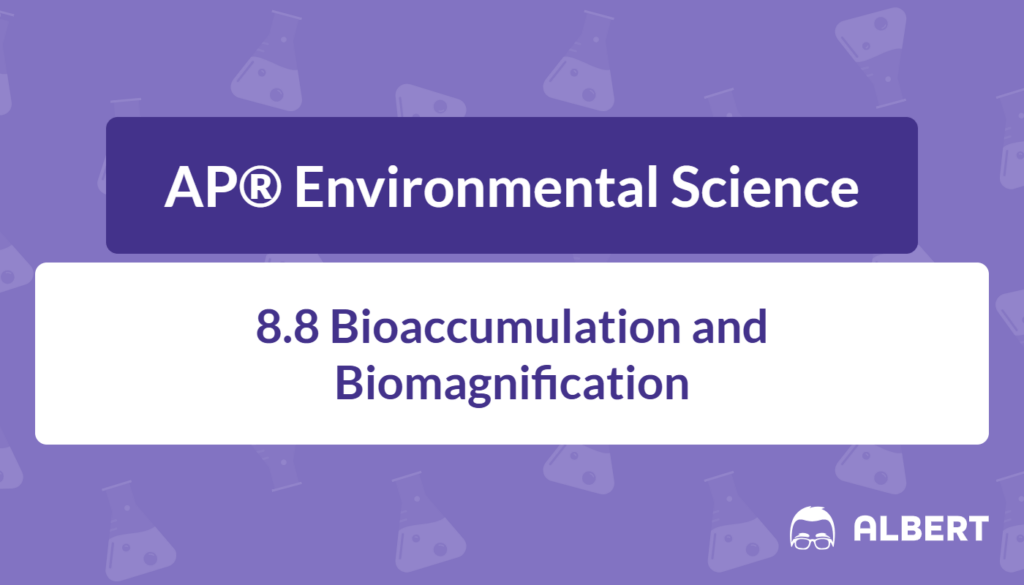What We Review
Introduction
Bioaccumulation and biomagnification are central concepts in AP® Environmental Science because they demonstrate how substances can move through food webs and accumulate in organisms at higher trophic levels. Understanding these processes is essential for evaluating the impact of environmental pollution on ecosystems and human health. Therefore, this article examines how certain chemicals build up in organisms (bioaccumulation) and then become more concentrated at higher levels of a food chain (biomagnification). These concepts are especially relevant when studying ecological balance, toxicology, and the sustainability of populations worldwide.
Many chemicals that undergo bioaccumulation are fat-soluble compounds, meaning they dissolve in fatty tissues and cannot be easily flushed out. Consequently, organisms exposed to these substances may suffer from developmental deformities or reproductive challenges. Moreover, top predators, including humans, often experience the most pronounced effects of biomagnification because they sit at the apex of the food chain.
What Is Bioaccumulation?
Bioaccumulation refers to the process by which chemicals, particularly toxic substances, build up within the tissues of a living organism. Over time, an organism absorbs these chemicals at a faster rate than it can eliminate them. Once absorbed, fat-soluble compounds remain in tissues and increase in concentration with each new intake of food or water.
Process of Bioaccumulation
- Substances enter the environment through industrial discharge, agricultural runoff, or atmospheric deposition.
- Organisms absorb these substances, often through feeding or direct contact (e.g., gills in fish).
- Elimination rates for fat-soluble compounds are low, so concentrations continue to rise.

These steps illustrate why organisms at any trophic level can suffer adverse effects over time. However, bioaccumulation alone does not explain why top predators might exhibit the highest levels of toxins—that is where biomagnification comes into play.
Example: Mercury Accumulation in Fish
Mercury provides a clear example of bioaccumulation in aquatic ecosystems. Although mercury is released into the environment naturally (e.g., volcanic activity), human activities such as coal burning also contribute significantly to mercury pollution. Examine the step-by-step progression:
- Mercury enters water bodies through industrial waste, mining, and atmospheric deposition.
- Tiny organisms, such as plankton, absorb mercury more rapidly than they can eliminate it. Mercury can bond with cellular structures and accumulate.
- Small fish consume significant amounts of plankton containing mercury. As a result, mercury levels within these fish steadily rise.
Therefore, even before reaching higher trophic levels, considerable concentrations of mercury can be measured in organisms that have limited capacity to excrete it.
What Is Biomagnification?
Biomagnification describes how the concentration of certain substances, such as pesticides or heavy metals, increases at each successive trophic level in a food chain. In other words, top predators end up with higher levels of these toxins than the organisms they feed on. This process can unfold through both simple food chains and complex food webs.
How Biomagnification Works
- Trophic levels define an organism’s position in a food chain.
- Each predator consumes multiple organisms from the level directly below.
- Toxins are retained in the predator’s fatty or other tissues, compounding with every meal.
Therefore, while bioaccumulation focuses on a single organism’s increasing levels of a substance over time, biomagnification explains how those levels intensify throughout an entire ecological system.
Example: Step-by-Step Food Chain Illustration
Consider a pesticide that has leached into a freshwater environment:
- Phytoplankton contain initially low concentrations of the pesticide. Most of these microscopic plants have short life spans, yet they still retain some pesticide in their tissues.
- Small fish feed on large quantities of phytoplankton every day, thereby accumulating higher pesticide concentrations in their tissues.
- Larger fish or birds of prey, which eat many small fish, end up with even greater levels of the pesticide as it travels up the food chain. Over time, these toxins can cause reproductive, neurological, and developmental problems.
Hence, the concentration of a toxic substance becomes magnified at higher trophic levels.
Real-World Implications of Bioaccumulation and Biomagnification
The real-world consequences of these processes are profound. In nature, many species rely on an interconnected food web, meaning that substantial damage to one species can create ripple effects across entire ecosystems.
Effects on Ecosystems
Organisms at higher trophic levels, including top carnivores, often exhibit the most severe symptoms due to biomagnification. For instance, eggshell thinning in birds of prey emerged as a result of DDT exposure in the mid-20th century. Developmental deformities in aquatic species, such as frogs and salamanders, also suggest how persistent substances disrupt normal growth patterns. Consequently, the decline of these predators or keystone species could destabilize ecological networks and reduce biodiversity.
In addition, because certain pollutants persist in bottom sediments, benthic organisms (those living on or near the sediment) may pass toxins back into the food chain long after the initial source of pollution has disappeared. Therefore, ecosystems often require decades of recovery time.
Effects on Human Health
Although biomagnification in wildlife is concerning, humans may also experience significant risks when consuming contaminated fish, animal products, or crops. These pollutants can harm the reproductive, nervous, and circulatory systems, sometimes leading to infertility or neurological disorders. Therefore, medical evaluations often include blood or hair tests for substances such as mercury. Monitoring these levels aids in guiding dietary recommendations and policy changes to protect public health.
Moreover, food safety agencies around the world routinely warn against excessive consumption of specific fish—like large predatory species (e.g., swordfish)—because of their elevated mercury content. Thus, human communities dependent on fishing as a source of protein remain vulnerable if they are not informed about toxin levels.
Notable Substances That Bioaccumulate
Certain chemicals are especially notorious for their capacity to persist in organisms and the environment. Many of these substances combine high toxicity with slow breakdown rates.
DDT
DDT (dichloro-diphenyl-trichloroethane) gained popularity in the mid-1900s as an effective pesticide for combating mosquitoes and agricultural pests. At the time, few regulations controlled pesticide use. Eventually, wildlife researchers discovered DDT residues in the tissues of birds and fish. Over time, these birds and fish developed reproductive and developmental issues, particularly thinning of bird eggshells. Governments worldwide began restricting or banning DDT in the 1970s, yet traces of it can still be detected in some ecosystems today.
Mercury
Mercury is a naturally occurring element found in Earth’s crust, but industrial processes, such as coal burning or gold mining, accelerate its release into the environment. Once in waterways, bacteria can convert mercury into methylmercury, a highly toxic form that readily accumulates in fish. Consumption of contaminated seafood can lead to neurological damage and other health complications, especially in developing fetuses. Consequently, pregnant individuals are often advised to avoid seafood that may contain elevated mercury levels.
PCBs (Polychlorinated Biphenyls)
PCBs were once widely used in electrical equipment, such as transformers and capacitors, due to their heat-resistant properties. Unfortunately, PCBs also persist in the environment for long periods, making them prime candidates for bioaccumulation. In aquatic food webs, PCBs can concentrate in fish tissues, causing harmful outcomes for both wildlife and humans. Long-term PCB exposure has been linked to immune system suppression, endocrine disruption, and potential carcinogenic effects.
Preventive Measures and Strategies
Although bioaccumulation and biomagnification are daunting challenges, there are methods to help protect ecosystems and public health.
- Reducing Pollution: Industrial practices are gradually shifting toward less harmful alternatives. Regulations now limit the amounts of toxins discharged into air and water, thereby lowering the initial input of persistent substances.
- Awareness and Education: People who understand these processes can make informed decisions when purchasing, producing, and disposing of goods. Educating communities about proper waste management and safe pesticide application also reduces pollution.
- Support for Regulatory Measures: Encouraging compliance with international treaties, such as the Stockholm Convention on Persistent Organic Pollutants, helps nations cooperate and implement consistent rules. These joint efforts are crucial for controlling multiple sources of hazardous substances.
- Ongoing Research: Scientists continually track contaminants in wildlife populations and document any health anomalies. Tracking changes in toxin levels ensures early detection of problems, prompting policy or conservation interventions before ecosystems face irreparable harm.
Therefore, combining regulation, innovation, and widespread education can mitigate the destructive effects of chemicals that readily bioaccumulate.
Conclusion
Bioaccumulation and biomagnification are pivotal concepts for comprehending how toxic substances travel through ecosystems. These processes highlight the complex interactions among species and stress the importance of studying trophic levels in a food chain or web. Harmful substances like DDT, mercury, and PCBs can remain in the environment for decades, posing threats to both biodiversity and human health.
Ecosystems often need considerable time to recover from chemical contamination, and some never fully return to their original conditions. Hence, it is vital to reduce pollution at its source and push for regulations that minimize the release of persistent compounds. By examining trends in wildlife populations and practicing responsible resource management, communities can safeguard ecosystems, ensuring that future generations continue to benefit from the diversity and stability of our planet’s life-support systems.
Important Vocabulary
- Bioaccumulation: The buildup of substances, such as pesticides, in the tissues of living organisms over time.
- Biomagnification: The increasing concentration of substances at higher trophic levels in a food chain or food web.
- Fat-soluble compounds: Chemicals that dissolve in fats and oils, making them difficult for organisms to eliminate.
- Trophic levels: Different positions in a food chain, reflecting how energy and nutrients pass from one group of organisms to another.
- Developmental deformities: Abnormal growth patterns in organisms, often resulting from prolonged exposure to toxic substances.
Sharpen Your Skills for AP® Environmental Science
Are you preparing for the AP® Environmental Science test? We’ve got you covered! Try our review articles designed to help you confidently tackle real-world AP® Environmental Science problems. You’ll find everything you need to succeed, from quick tips to detailed strategies. Start exploring now!
- AP® Environmental Science: 8.5 Review
- AP® Environmental Science: 8.6 Review
- AP® Environmental Science: 8.7 Review
Need help preparing for your AP® Environmental Science exam?
Albert has hundreds of AP® Environmental Science practice questions, free response, and full-length practice tests to try out.








